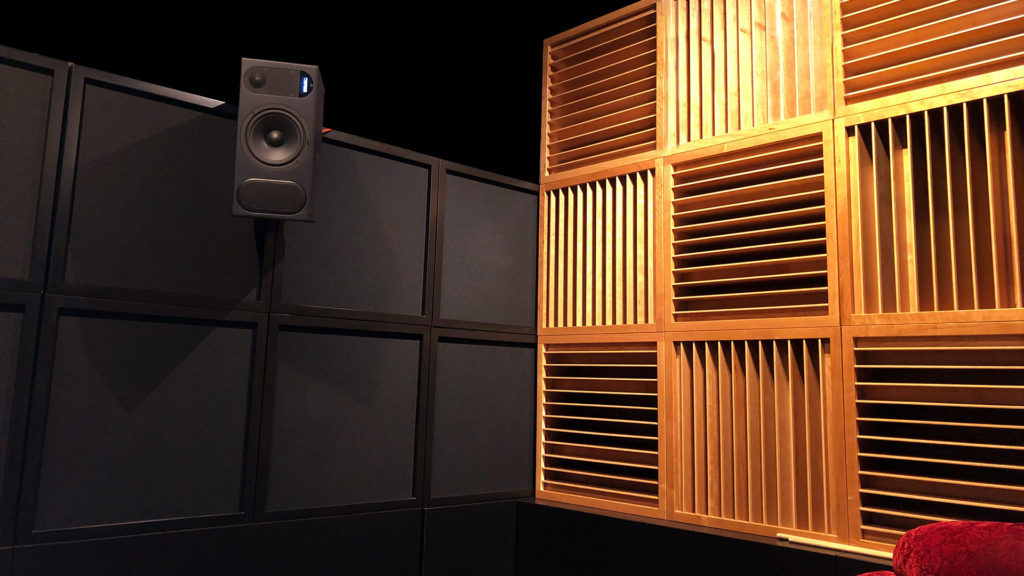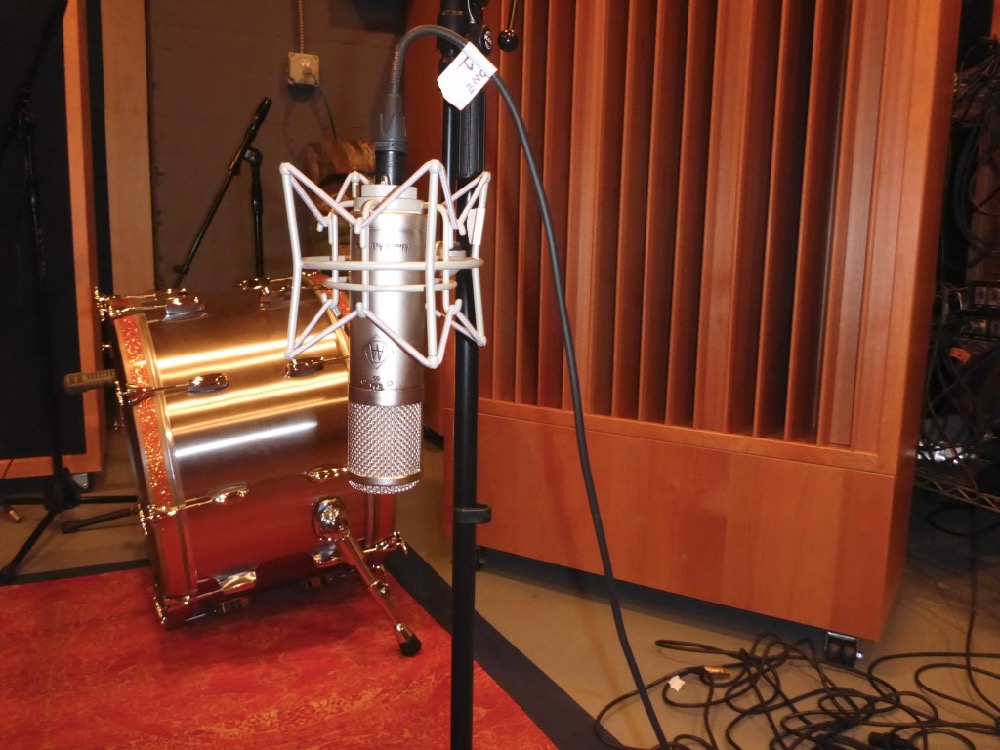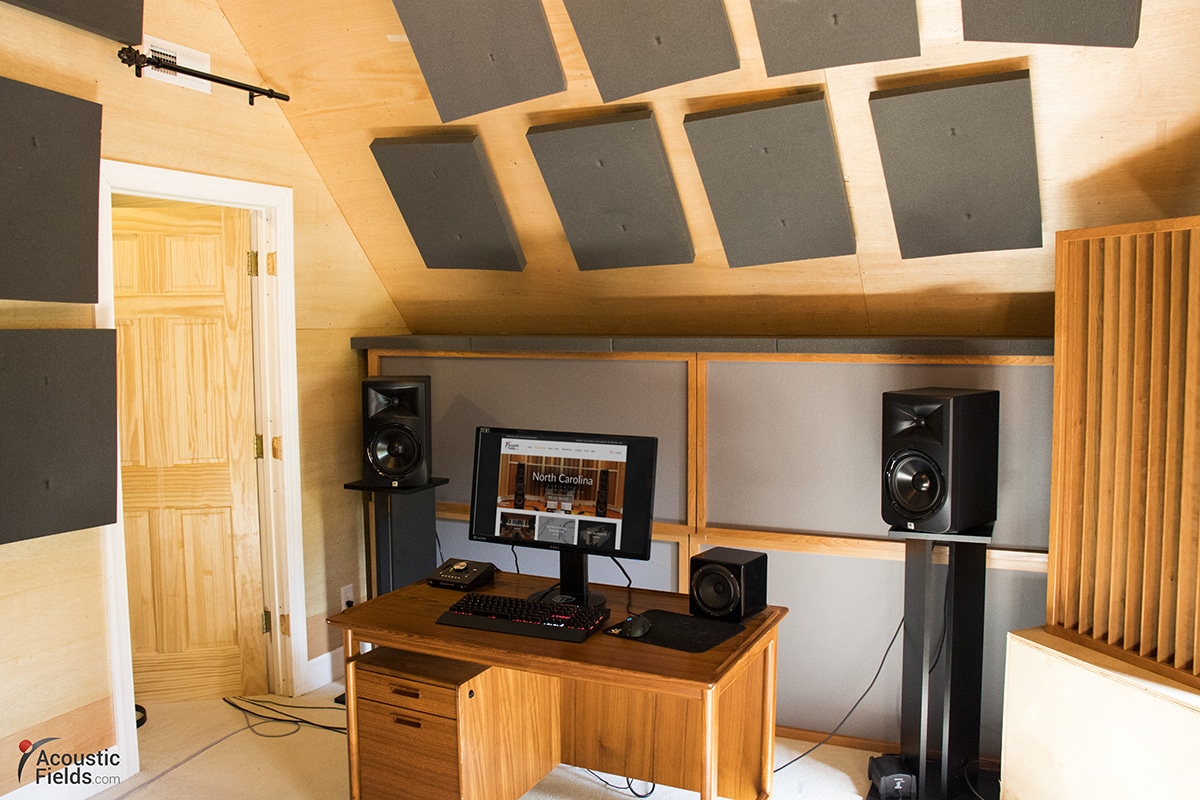
Acoustic treatment for home studios comes in two major types. We have absorption and diffusion. Absorption is further broken down into low frequency absorption and then middle and high frequency absorption. They are different technologies. Low frequency absorption focuses on sound pressure and middle and high frequency absorption focuses on air flow or molecular velocity. With acoustic treatment for home studios you must have the proper type, amount, and place it in the proper positions within the room to be effective. Unfortunately, the only way to apply acoustic treatment for home studios correctly is to cover enough surface area with treatment to produce a positive audible impact. Every surface area is a tuning fork. You must tune the wall by applying the correct treatment type,amount,and position:T.A.P.

T.A.P. – TYPE
Absorption
We have two types. We have only two types. Yes, there are hybrids but when you synthesize the hybrid down you get one part absorption and one part diffusion. Absorption produces an energy transformation at middle and high frequencies. Air movement across the treatment type produces friction and friction produces heat. Heat is an energy change and thus as a result of this energy transformation we have absorption. Energy is not lost. We have just changed it from an air borne missile to a ball of fire. With this friction / heat transformation, we can design products that only absorb middle and high frequencies.
Low -frequency absorption is different physics than we just described for middle and high frequency absorption. Low-frequency energy is wave energy and is pressure based. Middle and high frequency absorption works with air movement or molecular velocity. There are three types of pressure technologies. There are Helmholtz, membrane, and diaphragmatic. Diaphragmatic is the most powerful of the three. Diaphragmatic absorption must be in any acoustic treatment for home studios palette. Pound for pound and square feet of coverage versus square feet of coverage, diaphragmatic absorption can not be beaten.
Our Activated Carbon Absorber for home studios: https://www.acousticfields.com/product/acda-10-studio/
Diffusion
Diffusion is a technology that makes small rooms sound larger. It also reduces the impact of reflections so that the listener hears more of the straight line or direct energy from source to receiver. Diffusion takes large reflections from our wall surfaces and reduces the larger reflections into a series of smaller ones. Smaller in size compared to the straight or direct energy from source to receiver. Straight line energy has no reflections in it. It has less room sound. It is the shortest distance between two points. We call it straight-line energy. It’s like spring water. Diffusion can make a small room sound larger and add definition and separation to instruments and vocals. Get your absorption requirements satisfied. Get you Rt-30 times in line for usage. Then and only then can you add diffusion. If you do not take care of absorption requirements first, diffusion will make your room sound worse because diffusion will act as a magnifying glass and highlight the untreated or improperly treated room issues.

T.A.P. – AMOUNT
In any acoustic treatment for home studios, we must choose the correct treatment type but we must make sure we have enough of that technology to treat the frequency and amplitude of the unwanted room modal issues. Every surface area is a tuning fork and contributes 17% to the total room sound. We must first identify the frequency and amplitudes of all unwanted pressure areas between the floor and ceiling, both sidewalls, and the front and rear walls. Once identified and amplitude assessed, we treat with enough surface area to have the desired sonic goals of the room. We decide what we want the room to sound like regardless of usage and then assign the appropriate treatment types and amounts. Most home studios need at least 60% of each wall treated in order to have the desired audible impact.
QD-17 Quadratic Diffuser: https://www.acousticfields.com/product/sounddiffuser-acousticdiffuser-qd17/
T.A.P. – POSITION
Do we place low-frequency everywhere in small rooms? The short answer is yes. Every wall surface area, every floor to ceiling surface area, and every sidewall to sidewall area produces low-frequency issues below 100 Hz. These issues are a direct result of room ratios dimensions that do not allow for low-frequency pressure to naturally dissipate within the room. Diaphragmatic absorption can be built into the walls themselves, thus creating a room that responds evenly to the pressure inside the room from all wall surfaces. This is ideal since the more surface area coverage the better our chances of managing 30 100 Hz. energy. If we can not build it into the walls, we must have the required surface area coverage to deal with the appropriate frequency and amplitude of all the modal issues. This will require free standing units that will line the walls and go from floor to ceiling.

Acoustic treatment for home studios comes in two main forms. First, we have absorption. Absorption is broken down into low-frequency absorption and then middle and high frequency absorption. Low-frequency absorption needs to cover all wall surfaces within small studios. You must make the room smaller to make it sound better. Diffusion is a technology that psychoacoustically disrupts our ability to spatially locate. The reason a room sounds larger to us is because diffusion takes larger reflections which we use for echolocation and reduces the larger reflections to smaller ones which our brain does not “hear”, A 9′ ceiling height with diffusion across its surface can sound like 12′ to someone sitting in the listening chair.
About Us at Acoustic Fields: https://www.acousticfields.com/about/







